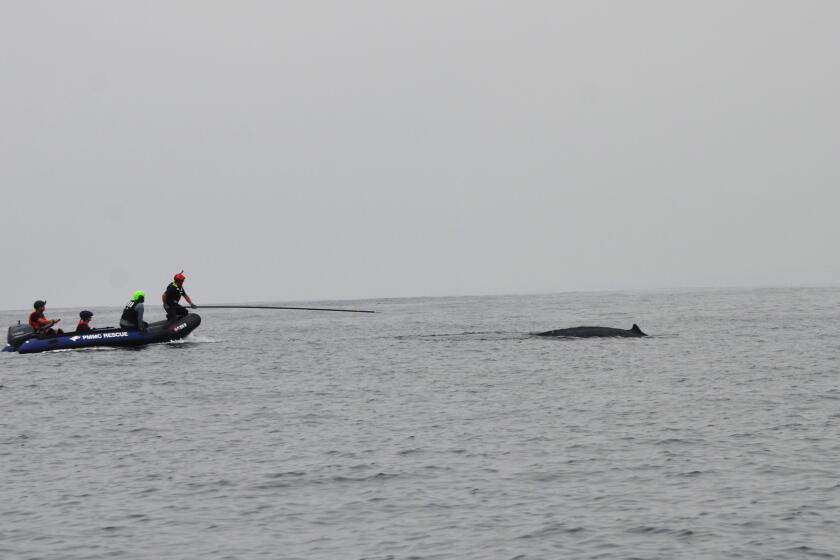Giant Yellowfin Tuna Make Trip Worthwhile
When the Royal Polaris pulls into San Diego Thursday morning, it will have aboard some worn out fishermen and some very large tuna--one that might weigh as much as 320 pounds.
The long-range season is in full swing and the Revillagigedo Island chain off mainland Mexico is more than living up to its reputation as the place to catch giant yellowfin tuna.
“It’s been good fishing on the big fish, yes,” said Frank LoPreste, owner of the Royal Polaris.
The huge yellowfin, caught by Sonny Schwaas of Murietta, was the fourth taken aboard the Royal Polaris this season that has topped 300 pounds.
The all-tackle record, a 388-pound 12-ounce yellowfin, was caught at the Revillagigedo’s San Benedicto Island in 1977.
The Royal Polaris crew on Thursday also will unload 10 tuna weighing more than 200 pounds and several exceeding 100.
“Ten fish over 200 is pretty excellent,” LoPreste said, adding that others were lost because they were too strong for the tackle.
“A lot of guys this trip got stripped, absolutely spooled on . . . 100-pound test line,” LoPreste said.
On the way home, skipper Steve Loomis stopped Tuesday at the Alijos Rocks off the Baja Coast, where by 8 a.m. his passengers had already boated 25 yellowfin up to 125 pounds.
Asked what these fishermen will do with so much tuna, LoPreste replied: “They’ll trade it for cans (of tuna). Some of them will take some of it fresh, and some of them will donate it to the St. Vincent DePaul Society.”
Fishermen scored a partial victory last week despite the California Coastal Commission’s vote to allow the resumption of dredge dumping near the Horseshoe Kelp.
The commission imposed a five-year limit with regular monitoring by the fishermen themselves and will require the Environmental Protection Agency, which proposed resumption, to take a better look at an alternate, deep-water site proposed by the fishermen.
Bob Fletcher, president of the Sportfishing Assn. of California, anticipated the decision when he told the commission, “If the commission adopts this recommendation, I’d ask that it allow my boats to become part of the monitoring plan. They’re out there every day.”
The commission and Patrick Cotter, regional ocean disposal coordinator for the EPA, agreed.
Typically, a tugboat will tow a barge laden with dredge material out of the harbor and an on-board bulldozer will shove it over the side.
But Fletcher claims they don’t always wait until they reach the designated LA-2 dumpsite but start dumping “as soon as they clear the breakwater” because the farther out they go, the more it costs.
The U.S. Army Corps of Engineers’ position was that denial of a designation would cause “severe economic impacts for the port and the nation.”
Thomas N. Crehan, general manager and general counsel for the (commercial) Fishermen’s Cooperative Assn. in San Pedro, opposed the five-year test period.
“That’s like injecting yourself with a toxic substance and seeing whether you live or die,” Crehan said.
Besides economics, the EPA’s objection to the deep-water site was that the area already has a low content of dissolved oxygen and further dumping of organic materials could create a condition in which no life could survive.
Jim Raives of the Coastal Commission staff said, “It could become a dead zone--a ‘black hole.’ ”
But fishermen don’t understand why authorities would prefer to jeopardize an established fishing area rather than one where there are no fish.
Briefly
POACHING--Three men who shot and killed a bighorn sheep in the San Gabriel Mountains Aug. 19 were put on two years’ probation after pleading no contest to violating fish and game laws. West Covina Municipal Court Commissioner Harold Mulville also offered them the choice of paying $1,175 in fines and penalties or performing 150 hours of community service with the Department of Forestry. Tom Troxell, 30, of Huntington Park, and Alan Rosado, 28, of Valinda, pleaded no contest to taking a protected mammal. Donald Kolath, 28, of Cudahy, pleaded no contest to unlawful possession of a mammal. The men used a 12-gauge shotgun, a .22-caliber rifle and a .44-caliber revolver. Bighorns are usually hunted with high-powered, long-range rifles equipped with telescopic sights. The men were ordered to turn over the weapons to fish and game authorities.
EXHIBIT--The unusual catch of a wolf eel last week by a fisherman aboard the Matt Walsh out of L.A. Harbor Sportfishing is the newest attraction at the Cabrillo Marine Museum in San Pedro, where it is on display with another that was donated last year, also by a local sportfisherman. Exhibit Director Mike Schaadt said he was pleased with the addition because the fish, with its canine-like teeth and the ability to uncoil with lightning-like speed to attack its prey, is considered a prime attraction. “It’s an impressive animal, there’s no doubt about it,” Schaadt said. “They’re very good for the visitor to look at.”
FLY FISHING--New York author Dick Talleur will demonstrate tying flies and present a program at the Sierra Pacific Flyfishers’ Thursday meeting at 6:30 at the Odyssey Restaurant in Mission Hills. Details: (818) 785-7306.
MISCELLANY--Dick Conti of the Department of Fish and Game is seeking volunteers for a desert water project in the Whipple Mountains in San Bernardino County, Jan. 26-27. They plan to replace tanks at two big game guzzlers. Details: (213) 256-0463. . . . The DFG reports that the state’s 1990 deer kill slipped to 26,156 from 28,654 in ’89. Reason: the ongoing drought, which suppressed fawn production.
Staff writer Rich Roberts contributed to this notebook.
Sign up for The Wild
We’ll help you find the best places to hike, bike and run, as well as the perfect silent spots for meditation and yoga.
You may occasionally receive promotional content from the Los Angeles Times.



